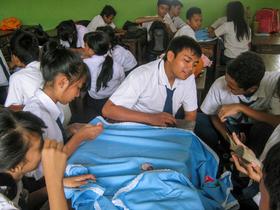For the 2025-26 school year, there are 6 public elementary schools serving 1,864 students in Wabash County Schools. This district's average elementary testing ranking is 6/10, which is in the top 50% of public elementary schools in Indiana.
Public Elementary Schools in Wabash County Schools have an average math proficiency score of 40% (versus the Indiana public elementary school average of 41%), and reading proficiency score of 43% (versus the 40% statewide average).
Minority enrollment is 11% of the student body (majority Hispanic), which is less than the Indiana public elementary school average of 37% (majority Hispanic and Black).
Overview
This School District
This State (IN)
# Schools
7 Schools
1,433 Schools
# Students
2,301 Students
662,155 Students
# Teachers
143 Teachers
44,024 Teachers
Student-Teacher Ratio
16:1
16:1
Student By Grade
District Rank
Wabash County Schools, which is ranked within the top 50% of all 389 school districts in Indiana (based off of combined math and reading proficiency testing data) for the 2022-2023 school year.
The school district's graduation rate of 62% has decreased from 85% over five school years.
Overall District Rank
#128 out of 395 school districts
(Top 50%)
(Top 50%)
Math Test Scores (% Proficient)
43%
39%
Reading/Language Arts Test Scores (% Proficient)
43%
41%
Science Test Scores (% Proficient)
43%
34%
Graduation Rate
62%
88%
Students by Ethnicity:
Diversity Score
0.20
0.57
% American Indian
n/a
n/a
% Asian
1%
3%
% Hispanic
4%
14%
% Black
2%
14%
% White
89%
63%
% Hawaiian
n/a
n/a
% Two or more races
4%
6%
All Ethnic Groups
District Revenue and Spending
The revenue/student of $12,203 in this school district is less than the state median of $13,184. The school district revenue/student has declined by 8% over four school years.
The school district's spending/student of $11,716 is less than the state median of $12,815. The school district spending/student has declined by 8% over four school years.
Total Revenue
$28 MM
$13,615 MM
Spending
$27 MM
$13,234 MM
Revenue / Student
$12,203
$13,184
Spending / Student
$11,716
$12,815
Best Wabash County Schools Public Elementary Schools (2025-26)
School
(Math and Reading Proficiency)
(Math and Reading Proficiency)
Location
Quick Facts
Rank: #11.
Southwood Elementary School
(Math: 50-54% | Reading: 58%)
Rank:
Rank:
9/
Top 20%10
840 E Sr 124
Wabash, IN 46992
(260) 563-8050
Wabash, IN 46992
(260) 563-8050
Gr: PK-5 | 425 students Student-teacher ratio: 14:1 Minority enrollment: 7%
Rank: #22.
Southwood Jr-sr High School
(Math: 38% | Reading: 45-49%)
Rank:
Rank:
7/
Top 50%10
564 E Sr 124
Wabash, IN 46992
(260) 563-8050
Wabash, IN 46992
(260) 563-8050
Gr: 6-12 | 457 students Student-teacher ratio: 14:1 Minority enrollment: 7%
Rank: #33.
Sharp Creek Elementary School
(Math: 50% | Reading: 36%)
Rank:
Rank:
6/
Top 50%10
264 W 200 N
Wabash, IN 46992
(260) 563-8050
Wabash, IN 46992
(260) 563-8050
Gr: 3-6 | 270 students Student-teacher ratio: 17:1 Minority enrollment: 6%
Rank: #44.
Metro North Elementary School
(Math: 45-49% | Reading: 30-34% )
Rank:
Rank:
5/
Bottom 50%10
3844 W 200 N
Wabash, IN 46992
(260) 563-8050
Wabash, IN 46992
(260) 563-8050
Gr: PK-2 | 291 students Student-teacher ratio: 15:1 Minority enrollment: 9%
Rank: #55.
White's Jr-sr High School
(Math: ≤5% | Reading: 15-19%)
Rank:
Rank:
1/
Bottom 50%10
5233 S 50 E
Wabash, IN 46992
(260) 563-1150
Wabash, IN 46992
(260) 563-1150
Gr: 6-12 | 421 students Student-teacher ratio: 32:1 Minority enrollment: 24%
Rank: n/an/a
Wabash/miami Area Prog Excpt
Special Education School
246 N 300 W
Wabash, IN 46992
(260) 563-8871
Wabash, IN 46992
(260) 563-8871
Gr: PK-12
Recent Articles

Charter Schools vs Public Schools 2025: Key Differences & Trends
Explore updated 2025 insights comparing charter schools vs public schools, enrollment, academic outcomes, funding, and real-world examples for families and educators.

Are Public Schools Ready for the 21st Century? 2025 Update
Explore 2025 insights on whether public schools are ready for the 21st century, covering performance, technology, equity, funding, and future-ready learning.

Public School Open House & Enrollment Season Guide
A parent-focused guide to the public school open house and enrollment season, with expert questions, timelines, and decision tips.





